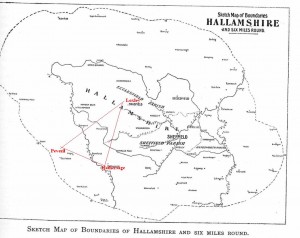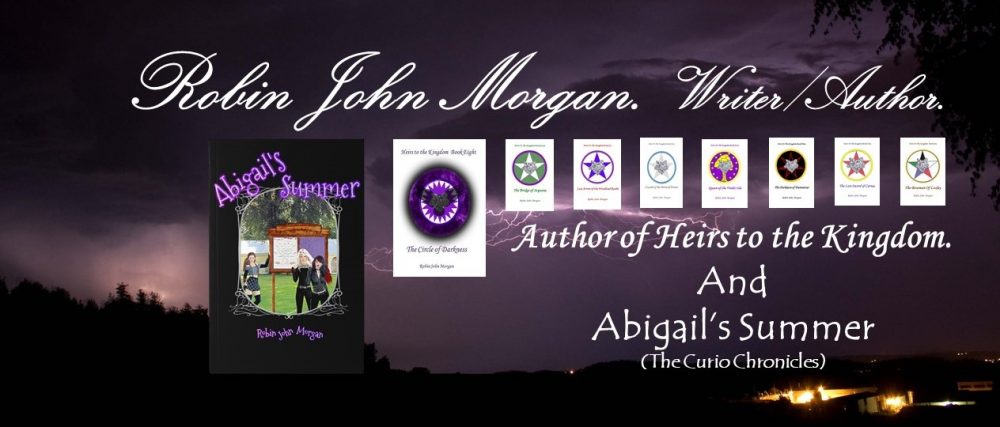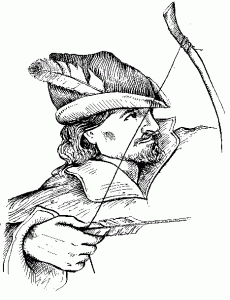I have harboured a fascination with the legend of Robin Hood and his merry men since I was very young, I think being named Robin helped, as it provided me with a wonderful chance to identify with the hero of the people, and fuelled many sessions of play as a child. I remember when I was young being shown an old walking stick carved from the branch of a tree by my grandmother, who told me this was the stick Robin Hood used when he was injured, and had been passed down through her family line since. As you can possibly imagine, I have spent a lifetime looking for that link that placed me in the family line of my hero, but today having come to a dead end, I can only surmise that my grandmother was stringing me on, and doing her bit to add to the magic of my childhood games.My search for a family connection did however lead me to some family connections in Chapel on le Frith in Derbyshire, which placed me on the old road that ran through the village towards Castleton, and then across the valley towards Loxley, and on to York. This was a road well used by the king and the church alike, a place that back in the eleventh century would have been densely wooded, and most suitable for ambushes and robbery. I think that back in those times, the talk would have centred a great deal around the actions of the hooded man, and maybe some of it has been passed down, and with time the story got altered and like so many others across this land, a claim to Robin Hood was made and romanticised over the years until it was told to myself by my grandmother.
Whatever the truth there is no doubt that it has become a sort of preoccupation with me over the years, and when my daughter was young I continued to tell my own tale of Robin, albeit a very different story. Robin Hood formed the background of my tale as I made up a story to tell her at bedtime, and in my version of events, a young boy who was the direct descendant of Robin Hood became the focus of attention in the country as his distant ancestor had. Looking back I can see that the reason the story I made up for my daughter stuck with me, was it was all a big part of my preoccupation with the hooded man, and maybe that is why I laboured for so long until I finally published my first book, which I entitled the “Bowman of Loxley.”
Everyone is aware of Nottingham’s claim to Robin Hood, and it is true that in those times the city was surrounded by Sherwood Forest, a forest that was huge and would indeed have provided many places for Robin to hide. The thing I have always had difficulty with was why would he have been named Loxley? Most people in those times were named after their place of birth, and Loxley is miles away from Nottingham. There is in fact two, the first close to Stratford upon Avon (Place A), which is easily found on a large map of the country, and Loxley near Sheffield in Barnsley (Place B), which is only marked on the more local maps. Neither of them relate to Nottingham, and as I found out in my travels, Place A does not have too many connections with Huntingdon, which after all is very significant, as Robin Hood was reportedly the son of the Earl of Huntingdon.
It did not take too long to work out that the Loxley I needed to focus on was in the Bradfield area of Sheffield, right on the edge of Derbyshire and Yorkshire, and situated very close to Hathersage and Castleton which are both very relevant to the legend of the Hooded Man. Hathersage is the birth place of John Little, and to this day his grave can been seen in the church yard there, and Castleton hosts the ruins of Peveril Castle, a castle built by William Peveril who was a Sheriff of Nottingham, and it was also a Castle that served as a hunting lodge for the king.

This map shows how closely related Loxley, Hathersage and Peveril castle at Castleton are, giving credibilty to the connection of Loxley to the legend
Rodger Dodsworth the famous historian quotes around 1600-1640AD “Robert Lockesley, born in Bradfeild parish of Hallamshire (Loxley)” which for myself was proof enough I was on the right track. He goes on to describe how Robin injured his father at the plough and ran into the woodlands to hide. He later was forgiven by his mother and returned to Clifton upon Calder, ( Barnsdale or Bansley as it is known today) and there he became acquainted with John Little. The Sloane manuscript in the British Museum contains the entry, “Robin Hood was borne at Locksley in Yorkshire.” These discoveries gave me great heart, after all I wanted to know the truth of my hero, and if I was as I have, used the background of the hooded man in my writing, I wanted to have it as factually correct as possible.
The picture was starting to form as I searched, but the frustrating thing was I found it hard to link Robin of Loxley with the earldom of Huntingdon. My big break came when I found a wonderful website http://robinhoodloxley.net in 2007. A surviving member of the Loxley family built this site, and it is filled with some extensive research about the legend of the hooded man. For me it was like a eureka moment having invested years of following wrong leads out of Nottingham, and with a great deal of joy I read a passage that mentions Robert of Loxley agreeing to support a Henry de Leke for the rest of his life in 1245AD. The man at least really existed.
Further into the site it mentions that Robert de Loxley was a close friend with William de Lovetot, Lord of the manor of Sheffield, and both of them held “Possessions in Huntingdon” It appears that that Williams’s brother was the Sheriff of Nottingham, and his land in Huntingdon bordered the land of Robert de Loxley, which was the missing link I had been searching for as it placed Loxley, Peveril Castle and Huntingdon together in a circle of connection. David, King of Scots was the Earl of Huntingdon and he was the tenant in chief of Loxley in Hallamshire (Barnsley) so I now had an Earl in the forest of Loxley. I have not been able to formally provide a concrete family connection with the Earl and Robert of Loxley, but I found several leads from a Robert Fitzooth, who was son of the Earl and related back to William the Conqueror, and took up residency in Peveril Castle as game keeper to the kings forest, which contains Loxley. Maybe this would explain why Robert of Loxley was such a defender of the king and opposed the crowning of Prince John, as he had a direct family connection to the king, in this I cannot be sure, but it does help strengthen the case for a link between Robin and Huntingdon.
I have spent years looking into Robin Hood and I am convinced he was a Yorkshire man and had very little to do with Nottingham, apart from his very well documented dispute with the sheriff. My biggest hurdle of course has always been Sherwood, the vast forest, which surrounded the city and is still present in a much-depleted form today. To find an answer I began to search through as many maps as possible, so I could get a clearer picture of the lay of the land in medieval times, and I was quite surprised at what I found. We forget how much has been destroyed over the years and none more so than the great forests of the past. Looking at old maps I think I much prefer Britain as it was back then, for there were a lot less roads and more wide-open and forested spaces. Most of Britain in medieval times was wild unspoilt natural countryside and woodland that believe or not covered two thirds of the country.
The Kings Forest as I have mentioned is what we today call the peak district. It’s hard to fully comprehend at first because that in itself covers most of Derbyshire and a little of Yorkshire. It was indeed a vast forest, and from what I have read it was the largest breeding ground of Sparrow Hawks, and has tales of there being so many deer, that some people were killed when they stampeded. To say the least it was one of the most important areas of wild game in the country, and was a very important asset to the king who shared a passion for hunting with Hawks. The Kings forest and Sherwood bordered each other, in fact there are many documented disputes over the boundaries of the forests and who had jurisdiction. We know that the Sheriff of Nottingham lived at Peveril Castle, which is at Castleton in Derbyshire, but it appears to me that back then it was held as territory of Nottingham, so maybe the borders of the City of Nottingham have shrunk away over time and with it the borders of Sherwood. I think that the two were in fact one large forest that were fought over by the lords who governed it, and like all things in medieval times the borders shifted with the fights for supremacy. I think it is clear that to an outlaw it would not make that much difference whether they were in Sherwood or the Kings Forest (Peak District), it would pretty much feel the same and so maybe most of that area was known as Sherwood.
The important fact is that the whole area from Loxley to Nottingham was forested, and patrolled by the Sheriffs bailiffs who enforced the laws and collected the taxes. Derbyshire certainly has a great many areas that carry the name of Robin Hood and have many legends relating to him, so much so that I do think it is more than just coincidence that so many places carry his name and in a greater concentration than anywhere else in the country. The legend and a search for facts is still an ongoing thing for me, and so hopefully over time I will add to the endless piles of paper I have collected to piece together yet more parts of my puzzle, of which only the basics are contained here. This land is filled with tales, and finding any grain of truth is not an easy task. For my own enjoyment and pleasure I do hold to the idea of him being a real live hero of the people, and in many ways I suppose, I like thousands before me, have carried on the tradition of keeping his name alive, even if it is the few facts contained within my books of a young boy in the future who finds out he has a link to him from the past.
We live in times where all of us see and feel the injustice of those who misuse power for their own gain, and in that I think is the wonder of this man of legend. All of us can identify with someone who fights for us and defends us when we cannot defend ourselves, it is a tale filled with the romance of a past time, yet very much applicable to our time now. I think it shows that even though we have progressed forward as a race into this world of ever changing technology, that some things will always remain the same, and no matter what happens in the future, there will always be those who steal for greed and power, and hopefully there will be those who will make a stand and fight for us. Long live the tales of the past and tales to come; the Hooded Man is an important part of our heritage as a nation, and I for one want to see it remain so.
When I feel I have finished my search, I may even put it all together in a small book, although there again, I may leave it all for my children to do, and thus continue the legacy of passing on the tale.

